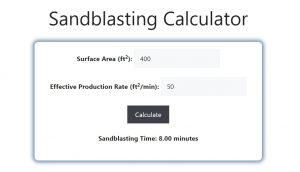About Sandblasting Calculator (Formula)
A Sandblasting Calculator is an invaluable tool for professionals in the construction and manufacturing industries, as it provides a quick and efficient way to determine how long it will take to sandblast a given surface area. Sandblasting, also known as abrasive blasting, involves propelling a stream of abrasive material against a surface to clean or prepare it for finishing. Understanding the time required for this process helps in project planning and resource allocation. This article will discuss the formula used in the sandblasting calculator, how to utilize it, a practical example, and address frequently asked questions.
Formula
The formula for calculating sandblasting time is:
Sandblasting Time = Surface Area / Effective Production Rate
Where:
- Surface Area is the total area to be sandblasted, measured in square feet or square meters.
- Effective Production Rate is the rate at which the sandblasting machine can effectively clean the surface, usually expressed in square feet or square meters per hour.
How to Use
- Measure the Surface Area: Determine the total area that requires sandblasting. This can be done using a measuring tape or by calculating the area of geometric shapes.
- Determine the Effective Production Rate: This rate can vary based on the equipment used, the type of abrasive material, and the nature of the surface. Refer to manufacturer specifications or previous project data for accurate rates.
- Apply the Formula: Divide the surface area by the effective production rate to find the sandblasting time.
Example
Suppose you need to sandblast a surface area of 400 square feet, and your equipment has an effective production rate of 50 square feet per hour.
Step 1: Identify the Surface Area and Production Rate
Surface Area = 400 sq. ft.
Effective Production Rate = 50 sq. ft./hr.
Step 2: Apply the Formula
Sandblasting Time = Surface Area / Effective Production Rate
Sandblasting Time = 400 sq. ft. / 50 sq. ft./hr.
Step 3: Calculate
Sandblasting Time = 8 hours
In this example, it would take approximately 8 hours to sandblast the entire surface area.

FAQs
- What is sandblasting?
Sandblasting is a process that uses a stream of abrasive material propelled at high speed to clean or prepare a surface. - What factors affect the sandblasting time?
Factors include surface area, effective production rate, type of abrasive material, equipment efficiency, and surface conditions. - How do I determine the effective production rate?
The effective production rate can be found in the equipment’s manual or by consulting with the equipment manufacturer. - Can the calculator be used for different surfaces?
Yes, the calculator can be used for various surfaces, including metal, wood, and concrete, although the production rate may differ. - What are some common uses for sandblasting?
Common uses include surface cleaning, rust removal, paint stripping, and preparing surfaces for coatings. - How can I improve my production rate?
Improving the production rate can be achieved by using more efficient equipment, selecting the right abrasive material, and optimizing the technique. - Is there a standard production rate for all equipment?
No, production rates vary by equipment type, so it’s essential to refer to the manufacturer’s specifications. - What types of abrasives are used in sandblasting?
Common abrasives include sand, glass beads, aluminum oxide, and steel grit. - Can I use the calculator for large industrial projects?
Yes, the calculator is suitable for projects of all sizes, from small to large industrial applications. - What safety precautions should I take when sandblasting?
Always wear appropriate personal protective equipment (PPE), including respirators, goggles, and gloves, and ensure proper ventilation. - What is the best way to clean up after sandblasting?
Use a vacuum system designed for dust collection or wet blasting methods to minimize airborne particles. - How do environmental conditions affect sandblasting?
Wind, humidity, and temperature can influence the effectiveness of sandblasting and should be considered when planning the project. - Can sandblasting be done indoors?
Yes, but it requires proper containment and ventilation systems to manage dust and debris. - What maintenance is required for sandblasting equipment?
Regular maintenance includes checking hoses, nozzles, and the air supply system for wear and tear. - How does the surface material affect sandblasting time?
Different materials have varying levels of hardness and texture, affecting the effectiveness and speed of the sandblasting process. - Is sandblasting environmentally friendly?
While sandblasting itself can produce waste, using eco-friendly abrasives and methods can mitigate environmental impact. - Can I sandblast delicate surfaces?
Caution is required with delicate surfaces; lighter abrasives and lower pressures should be used to prevent damage. - How often should I recalibrate my sandblasting equipment?
Calibration frequency depends on usage; regular checks are recommended to ensure consistent performance. - What is the difference between sandblasting and bead blasting?
Bead blasting uses glass beads instead of sand, resulting in a smoother finish, while sandblasting is more abrasive. - What should I do if my sandblasting project is taking longer than expected?
Evaluate your effective production rate and consider whether equipment maintenance or technique adjustments are needed.
Conclusion
The Sandblasting Calculator is a practical tool that simplifies the estimation of sandblasting time, aiding in project planning and efficiency. By understanding how to measure surface area and determine effective production rates, professionals can make informed decisions and optimize their workflows. Utilizing this calculator can ultimately lead to more efficient sandblasting operations and better project outcomes.